
Initially created to glorify King Louis XV of France, Place de la Concorde, one of the major public squares in central Paris, is located on the right bank of the Seine, between the Tuileries Gardens and the western terminus of the Champs-Élysées. Although known as a public square in central Paris, the long stretch of Place de la Concorde, popular for its theatres, cafés, luxury shops, and the annual Bastille Day Parade, is widely known in France as the most beautiful avenue in the world.
Sprawled out over 20 acres, and decorated with beautiful fountains, sculptures, along with a giant Egyptian obelisk, Place de la Concorde is built in the shape of an octagon with eight beautiful statues standing in each of its eight corners. The statues, representing the eight French cities, namely Strasbourg, Lyon, Marseille, Brest, Rouen, Bordeaux, Nantes, and Lille, are part of the original 18th-century design of the square by Ange-Jacques Gabriel.
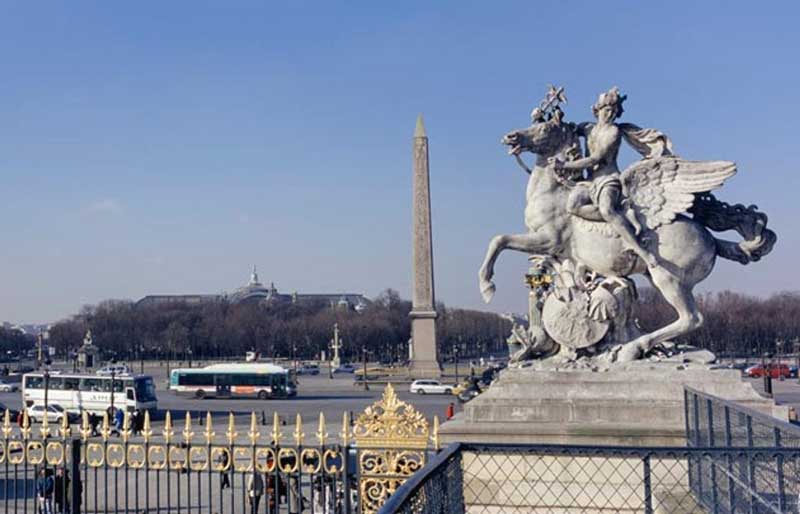
In 1748, Ange-Jacques Gabriel was commissioned by Louis XV to submit plans for the development of the marshy land between the gates of the Tuileries Palace Gardens and the new Champs-Élysées and to provide suitable surroundings for his previously commissioned equestrian bronze statue. The construction of the proposed square began in 1754, and after its completion in 1763, the new square was named Place Louis XV in honor of the King, showcasing the equestrian statue of the king. However, the statue had been commissioned earlier, in 1748, by the city of Paris, sculpted mostly by Edmé Bouchardon, and completed by Jean-Baptiste Pigalle, after the death of Bouchardon.
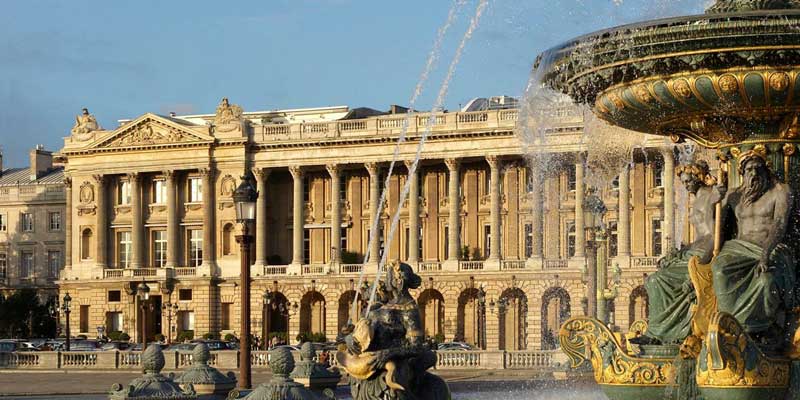

While the southwest side of the Square was left open to the River Seine, there are two magnificent identical stone buildings on the opposite side, flanking the Rue Royale, which are among the best examples of Louis Quinze’s style of architecture. The colonnaded facades of the majestic buildings, now occupied by the famous Hôtel de la Marine and Hôtel de Crillon, are somewhat reminiscent of the famous Louvre Museum in Paris.
While Hôtel de Crillon was converted into a luxury five-star hotel in the early 20th century, the Hôtel de la Marine still houses offices for the French navy. Located in the corner of the Place de la Concorde, at the intersection of Avenue Gabriel and Rue Boissy d'Anglas, the United States Embassy is the oldest diplomatic mission of the USA, which was designed much later, in 1933 by the New York architects.
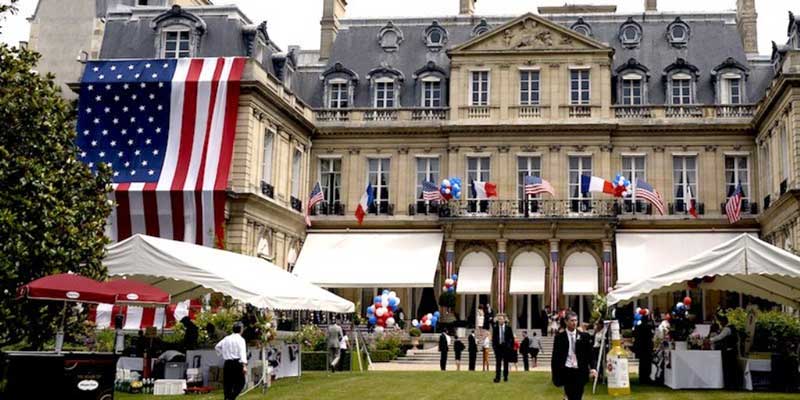
However, the unique attraction of the square is the 75 feet (23 m) tall Luxor obelisk that stands at its centre since its installation in 1836. The 3300 years old obelisk, made of red granite, and decorated with hieroglyphics exalting the reign of the Pharaoh Ramesses II, was once marked at the entrance to the Amon temple of Luxor and gifted to France in 1829 by Mehemet Ali, the Viceroy of Egypt. It arrived in France on 10 May 1833 and was installed on 25 October of that year, which proved to be a difficult task. Unfortunately, the top of the obelisk had been missing before it arrived in France, believed to be stolen in the 6th-century BC. However, in 1998, the French government added a gold-leafed pyramidal cap at its top to make it complete.
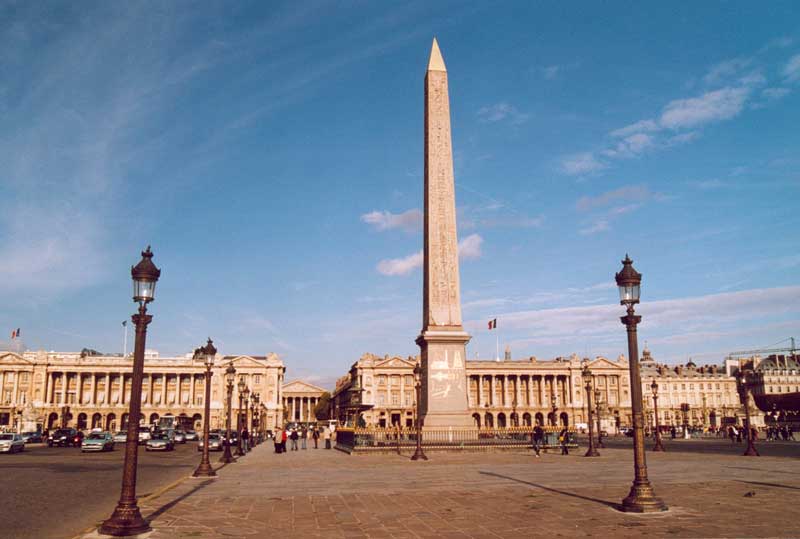
The obelisk is flanked by two beautiful fountains to its north and south. While the fountain on the south represents the maritime spirit of France, and its two large figures stand for the Atlantic Ocean and Mediterranean sea, the north fountain is devoted to the rivers of France, and the two big figures symbolize the Rhine and Rhone rivers.
Both the fountains have an identical stone basin, six figures of naiads or tritons holding fish spouting water, six seated mythological figures with their feet on the bows of ships, supporting the pedestal of the circular Vasque. Apart from that, there are another four statues of different forms of genius in arts or crafts supporting the upper inverted upper Vasque, whose water shot up and then cascaded down to the lower Vasque.
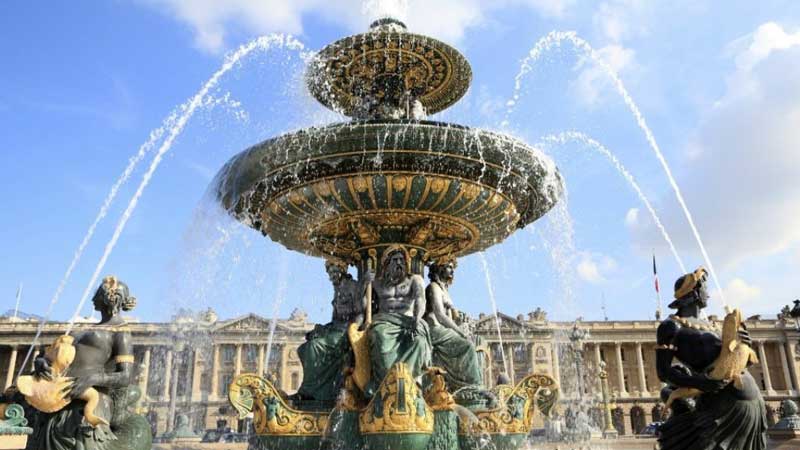
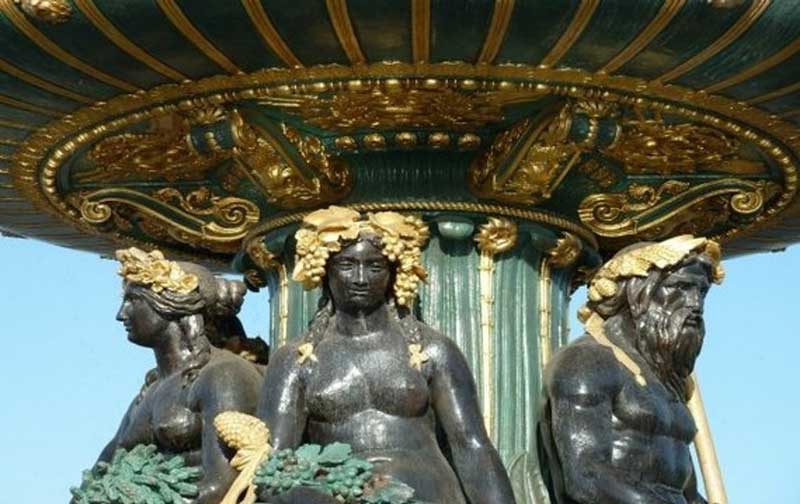
During the French Revolution in 1789, Place de la Concorde had witnessed the bloodiest chapter of French history. Amidst the tense situation and the excitement of revolutionary enthusiasm, the grand equestrian statue of Louis XV was torn down in 1792, and a guillotine was installed. In the following year, the square was renamed Place de la Révolution, and Louis XVI was guillotined in front of the cheering crowd on 21 January 1793, near the pedestal that now holds the statue of Brest. The barbaric executions continued for nearly three months, when many other important figures were guillotined on the site, including Queen Marie Antoinette, Princess Elisabeth of France, daughter of Louis XVI, Madame du Barry, the last chief Royal mistress of the king, Maximilien Robespierre, one of the most influential figures of the French Revolution, and Louis de Saint-Just, a Jacobin leader and a close friend of Robespierre. The guillotine was most active during the summer of 1794, known in history as the Reign of Terror, when in a single summer month more than 1400 people were executed by the guillotine.
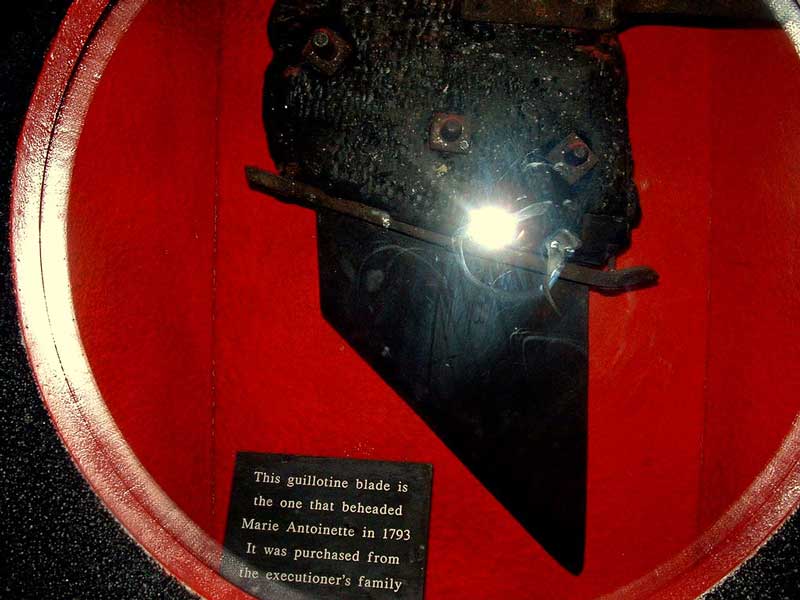
Under the Directory, the five-member governing committee in the First French Republic, the square was renamed Place de la Concorde in 1795. During that time, two monumental sculptures, the Horses of Marly, were installed at the entrance to the Champs-Élysées, which were subsequently replaced by replicas in 1984, while the originals were shifted to the Louvre for preservation. In the ensuing years, the name of the square was changed several times. While the name was changed back to Place Louis XV after the Bourbon Restoration of 1814, when the French royal family returned to power after the fall of Napoleon, and Place Louis XVI in 1826, it regained the name Place de la Concorde after the July Revolution of 1839, which it still retains.

The opulent Place de la Concorde, decorated with beautiful fountains, sculptures, and ancient Egyptian obelisk, attracts thousands of visitors from around the world. Its latest attraction is the addition of a 65-meter observation wheel that offers spectacular views over the City of Light. From its inception in 2000, it returns every year as a part of the Christmas village on the Avenue des Champs-Elysées. Complete with its 42 pods it rotates slowly to give visitors enough time and scope to view the alluring beauty of Paris with its historic landmarks, which include the Arc de Triomphe on the other end of the Champs-Elysées, along with Le Louvre, Eiffel Tower, and the River Seine.